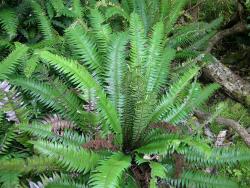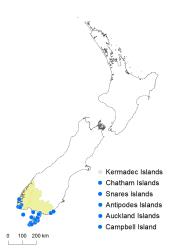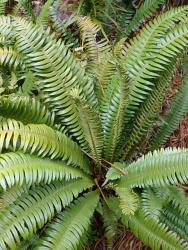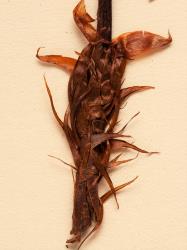- ≡ Lomaria dura T.Moore, Gard. Chron. 1866: 290 (1866)
- ≡ Spicanta dura (T.Moore) Kuntze, Revis. Gen. Pl. 2, 821 (1891)
- ≡ Struthiopteris dura (T.Moore) Ching, Sunyatsenia 5: 243 (1940)
- ≡ Austroblechnum durum (T.Moore) Gasper & V.A.O.Dittrich in Gasper et al., Phytotaxa 275: 202 (2016)
- = Lomaria rigida J.Sm., Ferns Brit. Foreign 290 (1866) nom. illeg., non Lomaria rigida Fée 1852
Rhizomes erect or suberect, sometimes forming a very short trunk up to 250 mm tall (in herbarium material), bearing scales. Rhizome scales ovate or narrowly ovate or linear, 10–20 mm long, 1–5 mm wide, chestnut-brown, usually bicolorous with continuous or interrupted black margins. Fronds strongly dimorphic; sterile fronds 140–820 mm long, arching upwards; fertile fronds on same plant usually slightly shorter, 110–675 mm long, positioned centrally, held erect. Sterile fronds. Stipes 10–110 mm long, red-brown, bearing a few bicolorous scales proximally. Rachises red-brown to yellow-brown, grooved adaxially, glabrous. Laminae 140–700 mm long, 22–125 mm wide, pinnatisect, narrowly elliptic to narrowly obovate, tapering to a short pinnatifid apex, dark green adaxially, paler green abaxially, fleshy, glabrous. Pinnae in 18–57 pairs, closely spaced, oblong to narrowly triangular, or triangular proximally, straight, gradually reducing to very short flanges at the lamina base; the longest pinnae at or above the middle, 12–68 mm long, 5–12 mm wide, apices obtuse to acute, margins entire or shallowly crenate, bases adnate; the basal pinnae alternate. Veins free. Fertile fronds. Stipes 10–155 mm long. Laminae 80–600 mm long, 22–70 mm wide. Pinnae in 20–55 pairs, linear to narrowly oblong, straight or slightly falcate, the longest 12–40 mm long, 1–5 mm wide, replaced by very short, sterile flanges at the lamina base. Sori and indusia in one row either side of the costa, continuous along the length of the pinna.
Blechnum durum is distinguished by its dimorphic fronds, free veins, pinnatisect sterile laminae, and continuous sori. It is confined to coastal habitats in the far south of the South Island, Stewart Island, and from the Chatham Islands to the subantarctic. It has fleshy fronds, and sterile laminae with narrowly triangular to oblong pinnae that are acute to obtuse at their apices, entire or slightly crenate on their margins, and adnate at their bases. The basal pinnae are arranged alternately. The laminae are glabrous and darker green on their adaxial surfaces, and the fertile fronds are only slightly shorter than the sterile fronds.
Blechnum durum is likely to be confused only with B. banksii, which also occurs in coastal habitats. The former can be distinguished by its larger sterile laminae (140–700 mm long, 25–125 mm wide, cf. 30–440 mm long, 5–40 mm wide), fertile fronds that are only slightly shorter than the sterile, more crowded fertile pinnae, and scales on the rhizome and lower stipe that have black margins.
South Island: Southland, Fiordland.
Chatham Islands, Solander Island, Stewart Island, Snares Islands, Antipodes Islands, Auckland Islands, Campbell Island.
Altitudinal range: 0–260 m.
Blechnum durum occurs only in coastal regions of the far south from Fiordland to the Catlins district, on Stewart Island, the Chatham Islands and the subantarctic islands. It never grows above c. 20 m on the South Island, but reaches 180 m on Antipodes Island and 260 m on Chatham Island.
Blechnum durum is a terrestrial fern of salt-spray, confined to damp rocks, boulders, cliffs, peat, and stream banks close to the sea. It often forms dense colonies under coastal forest and in Veronica elliptica, Brachyglottis rotundifolia or Olearia scrub. In the subantarctic it grows in Poa litorosa tussock, Dracophyllum scrub and Bulbinella herbfield. It is frequently associated with Blechnum banksii, Asplenium obtusatum and A. scleroprium.
n = 28 Brownlie 1954), 2n = 66 (Chambers 1954).







